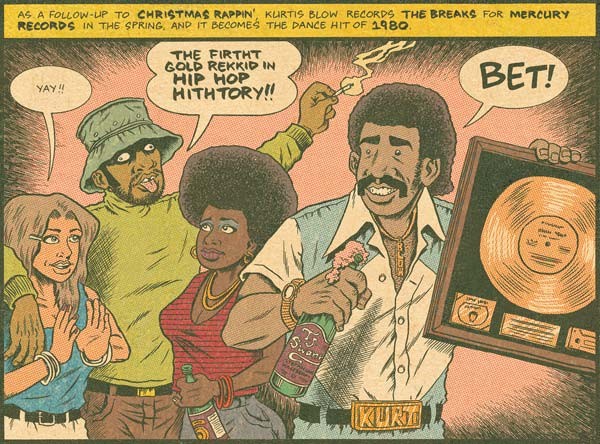Best Comic I Read this Past Week: ‘Hip Hop Family Tree’ Volume One
Welcome to Best Comic I Read, a column where I talk about the best comic I’ve read each week. It doesn’t have to have actually come out this week. It doesn’t have to be any particular format. The comic just has to be good. “Best” is subjective to be sure, but this is why I love what I’m reading.
This week the best book was Ed Piskor’s Hip Hop Family Tree volume one. The moment I flipped the book open to the end papers and it was adorned with headshots of the cast, I knew it would be. The brown pages emulated old newsprint comics. It was exciting, new, electric, but also reassuringly familiar.
Hip Hop Family Tree is the history of hip hop from the start as a living form of music on the street and in the clubs where it evolved organically from DJ’s and Emcees doing their thing. Lots of time is devoted to Afrika Bambaataa and Grandmaster Flash. It’s a whole thirty pages before it even begins to suggest recording hip-hop is possible. It covers the 70’s up until ’81 where volume two takes over. You shouldn’t read this as a recap, the book explains it so much better.
I am not well acquainted with hip hop. So for me it was a waypoint into an art form I wasn’t acquainted with through one I was intimately familiar with (comics). The intersection of new and lovingly old is perfect for me, but also speaks volumes about Piskor as an artist. He blends his two loves together and it is entirely his own. Much like the sampling of music in hip hop itself. (Isn’t critical analysis fun?)
Comics are a visual medium, but I’ve seen few comics that use their art to convey something immaterial as well as this one. Music can’t be seen and in most cases using speech bubbles and song notes to convey music falls flat. Here, with Piskor as the sole artist, he can display exactly how he feels about the music. It’s so exaggerated but emotionally real. He makes the people move like they do in his head, like superheroes. At the same time, much like the best superhero artists he’s referencing here, the quiet moments have the characters posing remarkably human.
The storytelling is remarkable. Scene changes are abrupt and no time is spent on filler. Every panel has a purpose and reason for why it is where it is. It makes use of both standard nine panel and wight panel but has no devotion to it. It’s a fascinating study into panel structure and one worth studying if you like that. The color works with a limited palette in the vein but is used to show amazing contrast. Every group has a home club and they’re colored so that you could follow them by just that. I don’t presently have the vocabulary to explain this book or do it any sort of justice.
The format and trade dress is absolutely gorgeous. It’s an oversized book in the style of 1970’s Big Two Treasury editions with borders and logos resembling a Marvel comic at the time the real life events happened. (Upon further Googling, the series was released in twelve single issues prior with the covers each referencing a classic comic cover. Homages ranged from the Dark Pheonix to Uncle Scrooge.)
It has a bibliography of researched works, a complete list of all the tracks featured, and an index of you want to focus in on just one artist or group. This is not just a comic, it’s a resource. I read the book and listened to the Spotify playlist twice. Once by themselves and then together. It’s not a book, it’s an experience.
It’s music, classic Marvel, and research. A trifecta of all my favorite things. I’ve only read the first volume and I can’t wait to start the second. Peace out, Y’all.
Available digitally and in print. Print is highly recommended.


